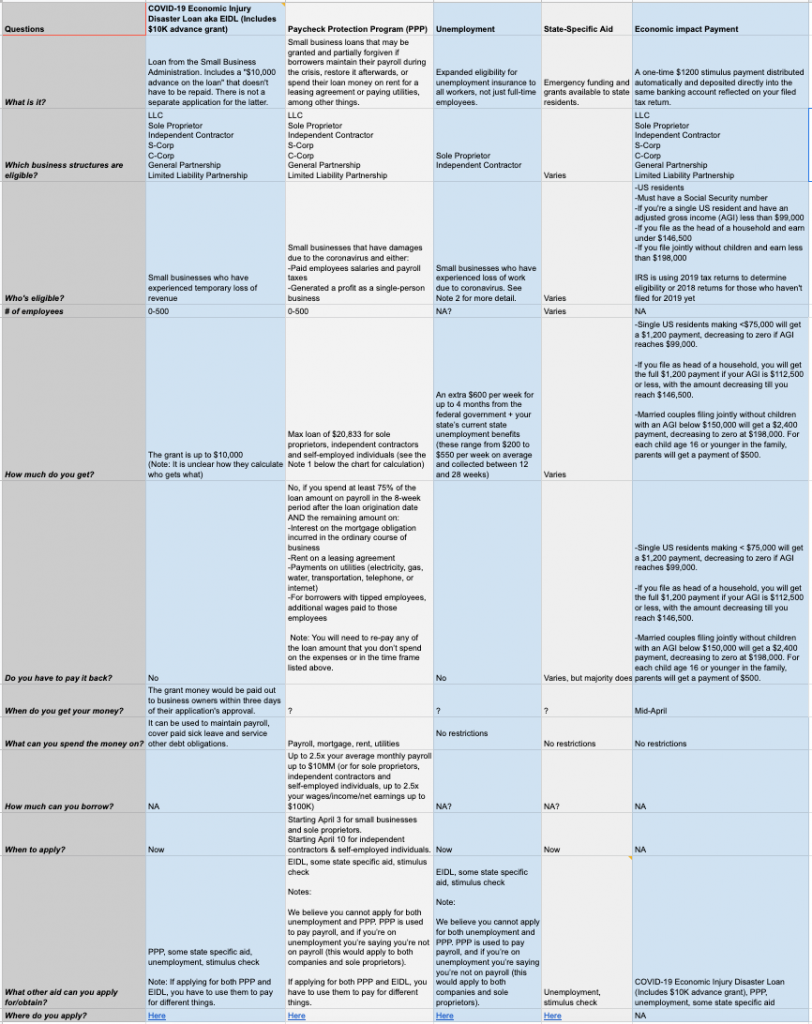
Updated 5/20/2020: The PPP Loan Forgiveness Application is now available; we also added a Maximum PPP Loan Forgiveness Amount Calculator to help you calculate PPP loan forgiveness amount.
With coronavirus impacting many small businesses, many have been asking about what’s available in terms of self employed unemployment benefits and small business relief. As part of the Senate’s $2T coronavirus stimulus bill passed on March 25, 2020, unemployment benefits are being extended to all workers including freelancers, gig-economy workers, and other independent contractors. For small business owners, emergency grants of up to $10,000, a Paycheck Protection Program (100% federally guaranteed loans to small businesses), and a payroll tax credit to help retain employees are available.
On April 24, Congress approved $310B in new loan money for the PPP. Learn if you should apply, where to apply & what’s changing in this second round PPP.
CARES Act Aid Comparison Chart (PPP vs EIDL vs Unemployment for Self Employed) for Small Businesses
As we’ve heard how challenging it can be to fully understand what’s included in each CARES Act relief option that applies to small businesses, we put together a comparison chart summarizing PPP loan for self employed vs EIDL vs Unemployment for Self Employed Individuals and the differences between them. To view the chart below, click here or on the image below.

Self Employed Unemployment
If you are unemployed, laid off, or a freelancer (sole-proprietor or single-member LLC) out of work, here’s what’s new:
- Eligibility for unemployment insurance extended for all workers, not just full-time employees.
- The federal government will provide an extra $600 per week for up to 4 months on top of your state’s current state unemployment benefits.
- State unemployment benefits range from $200 to $550 per week on average and collected between 12 and 28 weeks.
For additional information, check out the FAQ below.
Is the stimulus package finalized?
Yes. Both the Senate and House of Representatives have passed the plan and Donald Trump has signed the bill as of Friday, March 27.
Can you get unemployment if you are self employed?
Self-employed and part-time workers are not usually eligible for unemployment benefits. However, the new bill extends unemployment to self employed people and part-time workers. Self-employed people include gig workers, freelancers and independent contractors. Basically, those who cannot work due to coronavirus-related reasons would be more likely to qualify for benefits.
Who is eligible?
Under the new plan, you would be eligible if you meet any of the example conditions below:
- You are self employed or part time and lost work due to a coronavirus reason
- You received a COVID-19 diagnosis, are experiencing symptoms, seeking a diagnosis or caring for a member of your family/household who received a diagnosis AND you’re unemployed, partly unemployed or cannot work as a result
- You rely on a facility, daycare or school to care for a child or other family member so you can work, and that facility has closed due to coronavirus
- You must self-quarantine on the advice of a healthcare provider because of exposure to coronavirus
- You are unable to get to work because of an imposed quarantine
- You were about to start a new job but can’t get there now because of an outbreak
- You were immediately laid off from a job and don’t have enough work history to qualify for benefits under normal conditions
- You are unemployed, partly unemployed or unable to work because your employer shut down your workplace
Who is not included in the bill?
- Workers who are able to work from home (Note: This seems to reference corporate workers and not self-employed or part-time workers who work from home.)
- Those receiving paid sick leave or paid family leave
- New entrants to the work force who cannot find jobs
- People who quit (or want to quit) because they are afraid of being at greater risk of contracting coronavirus if they continue to work (However, if you had to quit because of a healthcare provider-recommended quarantine, or something similar, you would be eligible.)
How much would you get?
How much you get depends on which state you live in and would be calculated based on your previous income. Additionally, eligible workers would get an extra $600 per week from the federal government on top of their state’s weekly benefit.
So for example, the weekly benefit in California is a maximum of $450. With the additional $600 from the federal government, eligible Californians could receive self employed unemployment benefits up to $1050 each week. States can send the payment in two separate amounts or in one payment, but it must be paid weekly.
How long would benefits last?
This also varies by state. Most states provide benefits for 26 weeks, although some provide benefits for less. The new bill adds an additional 13 weeks for all eligible workers. 39 weeks is the maximum time eligible workers can receive benefits, but this may be less depending on the state.
The extra $600 payment would last for up to four months and cover weeks of unemployment ending July 31.
How long would the self employed unemployment program last?
The extended program would be open to workers who were newly eligible for unemployment benefits starting Jan. 27, 2020 through Dec. 31, 2020.
How do I apply?
Unemployment benefits will be administered by your state’s unemployment offices. To Apply, find your state here and click on the link to apply with your state’s office. Or for more information about filing for self employed unemployment benefits, check this unemployment benefits finder.
Please note: According to careeronestop.org, “States are in the process of implementing these new rules and may not have updated information immediately. If you are out of work or have had your hours reduced you should continue to follow your state’s guidelines for filing for unemployment. Many states are experiencing extensive traffic and ask filers to be patient and persistent.”
Coronavirus Stimulus Package Relief
If you are a small business owner, here’s what’s new:
- Emergency grants of up to $10,000 as part of an Economic Injury Disaster Loan
- Paycheck Protection Program (PPP loan for self employed individuals and small businesses)
- A payroll tax credit to help retain employees
Economic Injury Disaster Loan (Includes emergency grant up to $10K)
Small businesses may apply directly to the federal Small Business Administration to receive an economic injury disaster loan that may include a grant of up to $10,000 that does not need to be paid back. The money would be paid out to business owners within three days of their application’s submission. It can be used to maintain payroll, cover paid sick leave and service other debt obligations.
Update as of 4/9/2020
The amount of the grant depends upon number of employees in your business. In an email received from the SBA on April 9, they say, “To ensure that the greatest number of applicants can receive assistance during this challenging time, the amount of your Advance will be determined by the number of your pre-disaster (i.e., as of January 31, 2020) employees. The Advance will provide $1,000 per employee up to a maximum of $10,000.”
How to apply?
Paycheck Protection Program Loans (PPP loan for self employed individuals and small businesses)
As part of the Senate bill, $350B is being designated for small business loans (an initiative known as the Paycheck Protection Program) that may be granted and partially forgiven if borrowers maintain their payroll during the crisis, restore it afterwards, or spend their loan money on rent for a leasing agreement or paying utilities, among other things.
Go here for the Paycheck Protection Program Loan Forgiveness Application.
Should I apply for PPP?
If you don’t know whether you should apply for PPP, please check the comparison chart of eligibility and benefits for PPP vs. Economic Injury Disaster Loan (EIDL) vs. Unemployment and the differences between these options.
Note that we believe you cannot apply for both unemployment and PPP. PPP is used to pay payroll, and if you’re on unemployment you’re saying you’re not on payroll (this would apply to both companies and sole proprietors). Because of this, you may want to calculate how much you would receive from Unemployment and compare that to how much you would receive (and that would be forgiven) in a PPP loan, and apply to the program that provides the greater benefit.
How to apply for PPP loan for self employed individuals and small business?
These new loans will be available through over 800 lending institutions approved by the Small Business Administration. Apply for the Paycheck Protection Loan directly through your local lending institution. Find participating lenders at https://www.sba.gov/.
Here’s the Paycheck Protection Program application provided by the U.S. Treasury.
When to apply for the Paycheck Protection Program?
Small businesses and sole proprietors can apply starting April 3. Independent contractors and self-employed individuals can apply starting April 10. Because there is a limit to how much aid is available, be sure to apply quickly.
Who is eligible?
You are eligible if you are one of the following:
- An individual who operates as a sole proprietor
- An individual who operates as an independent contractor
- A small business with fewer than 500 employees
- A small business that otherwise meets the SBA’s size standard
- A 501(c)(3) with fewer than 500 employees
- An individual who is self-employed who regularly carries on any trade or business
- A Tribal business concern that meets the SBA size standard
- A 501(c)(19) Veterans Organization that meets the SBA size standard
What will lenders look for?
Lenders will be checking for the following requirements:
- Your business was in operation before February 15, 2020 and had employees for whom you paid salaries and payroll taxes or paid independent contractors (including yourself)
- Good faith certification that states
- The loan is a necessity due to the uncertainty of current economic conditions
- You will use the loan to retain workers and maintain payroll or make mortgage, lease and utility payments
- You do not have a pending application for a loan of the same amount or purpose as the PPP loan
- You have not received a loan for the same amount or purpose as the PPP loan from February 15, 2020 to December 31, 2020.
- For independent contractors, sole proprietors, or self-employed individuals, you will be asked to provide:
- payroll tax filings
- Forms 1099-MISC
- and income and expenses from the sole proprietorship
- See below for additional details.
What forms are required for the PPP application process?
- Payroll summary report for last 12 months
- IRS Form 940 & 941 (payroll tax forms)
- 2019 business tax returns (or 2018 return if 2019 is not yet filed)
- 2019 year-end financials (if tax return is not prepared)
- Statement of payroll benefits offered to employees
- Evidence of payroll taxes, insurance premiums and benefits paid
- Driver’s licenses for all owners with 20% or greater ownership stake
- Entity formation documents:
- Articles of Incorporation (or Articles of Organization)
- Bylaws and Operating Agreement
- Tax ID Number (Employer Identification Number)
- Board of Directors Minutes (if applicable)
- Ownership Verification (if applicable)
How much can I borrow through a PPP loan for self employed people and small businesses?
- Loans may be approved for up to 2.5x of your average monthly payroll up to $10 million
- For sole proprietors, independent contractors, and self-employed individuals, your payroll equals the sum of payments of any compensation or income you received that is a wage, commission, income, net earnings from self-employment, and that is in an amount that is not more than $100,000 in one year, as pro-rated for the covered period
- For example, if you make $100,000 in a year, your average monthly payroll to yourself would be $8,333. 2.5 x 8333=20,833. Your loan amount would be $20,833.
- For more detail on how payroll costs are calculated and defined, see the U.S. Chamber of Commerce Coronavirus Emergency Loans Small Business Guide and Checklist
- Additionally, businesses who qualify for the $10,000 grant will see the amount of their loan forgiveness reduced by the amount of their grant
How much will be forgiven?
Part of your PPP loan is eligible to be forgiven. The forgiven amount equals how much you spend on the following items in the 8-week period after the loan origination date:
- Payroll costs (using the same definition of payroll costs used to determine loan eligibility)
- Interest on the mortgage obligation incurred in the ordinary course of business
- Rent on a leasing agreement
- Payments on utilities (electricity, gas, water, transportation, telephone, or internet)
- For borrowers with tipped employees, additional wages paid to those employees
Any part of the loan that is not forgiven will have a 1% interest rate.
How do I apply for PPP loan forgiveness?
To apply for PPP loan forgiveness, you must complete the PPP Loan Forgiveness Application as directed and submit it to the lender servicing your loan. You may also complete the PPP Loan Forgiveness Application online through your lender.
When will the loan be forgiven?
The loan will be forgiven at the end of the 8-week period after your loan is funded.
Can you refinance EIDL into a PPP loan/grant?
Yes, as long as you do not duplicate the purposes for the funding and subtract other EIDL grant awards, you can refinance for loan forgiveness purposes.
For more detail
Check out the U.S. Chamber of Commerce Coronavirus Emergency Loans Small Business Guide and Checklist.
A payroll tax credit to help retain employees
Businesses that have experienced a 50% drop in gross receipts relative to the same quarter last year may qualify for a payroll tax credit worth up to $10,000 per employee so long as they are still paying their employees wages and/or health benefits.
To read the entire coronavirus stimulus bill, go here for the full text of the Coronavirus Aid, Relief, and Economic Security (CARES) Act.
If you need a small business management platform, try HoneyBook.
[CTA_A title=”Manage the effects of the coronavirus outbreak on your business
“]
Get tools, contracts and email templates to communicate with your clients, reschedule events and bring in more income.
START FREE TRIAL
[/CTA_A]
More Resources
- Business Continuity Plan for Small Business – How to Prepare Your Business for Coronavirus – 18 protection steps
- What to Say When: Swipe Copy for Responding to Coronavirus Scenarios
- How to Manage Your Mental Health in the Face of Coronavirus Uncertainty
- Coronavirus & Small Businesses Resource Hub
- Force Majeure Clause Sample [Free Template]
- Small Business Relief Resources for Coronavirus
- How to Initiate Postponements and Cancellations Regarding Coronavirus (& What to Do With Your Client Contracts)
- How to Prevent Event Cancellations [Plus, Free Email Templates]
- Coronavirus and Marketing: How to Update Your Marketing Strategy & Messaging
- How to Avoid Disputes: Proactive & Quick Communication Is the Key
- [Video] An Update From The Legal Paige on Force Majeure & What It Means for Your Business
- How to Make Money During Quarantine: 19 Ideas to Add Revenue Now


